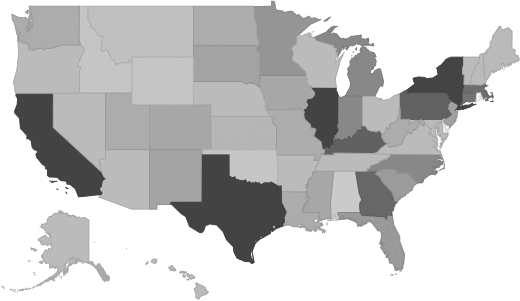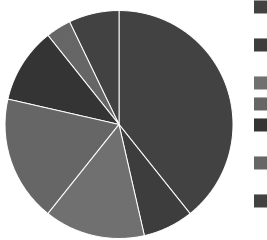Foundries Industry - Market Research Report
Industry Overview
This industry group comprises establishments primarily engaged in pouring molten metal into molds or dies to form castings. Establishments making castings and further manufacturing, such as machining or assembling, a specific manufactured product are classified in the industry of the finished product. Foundries may perform operations, such as cleaning and deburring, on the castings they manufacture. More involved processes, such as tapping, threading, milling, or machining to tight tolerances, that transform castings into more finished products are classified elsewhere in the Manufacturing sector based on the product made. Establishments in this industry group make castings from purchased metals or in integrated secondary smelting and casting facilities. When the production of primary metals is combined with making castings, the establishment is classified in Subsector 331, Primary Metal Manufacturing, with the primary metal made.
Source: U.S. Census BureauMarket Size and Industry Forecast
This research report analyzes the market size and trends in the Foundries industry. It shows overall market size from 2020 to the present, and predicts industry growth through 2030. Revenues data include both public and private companies.
| Historical | Forecasted |
|---|
| 2020 | 2021 | 2022 | 2023 | 2024 | 2025 | 2026 | 2027 | 2028 | 2029 | 2030 |
|---|
| Market Size (Total Revenue) | Included in Report |
| % Growth Rate |
| Number of Companies |
| Total Employees |
| Average Revenue per Company |
| Average Employees per Company |
Source: U.S. government financial dataIndustry Revenue ($ Billions)

Industry Forecast ($ Billions)

Advanced econometric models forecast five years of industry growth based on short- and long-term trend analysis. Market size includes revenue generated from all products and services sold within the industry.
Geographic Breakdown by U.S. State
Market size by state reveals local opportunity through the number of companies located in the region. Each state's growth rate is affected by regional economic conditions. Data by state can be used to pinpoint profitable and nonprofitable locations for Foundries companies in the United States.
Foundries Revenue by State

Distribution by Company Size
| Company Size | All Industries | Foundries |
|---|
| Small Business (< 5 Employees) | Included |
| Small Business (5 - 20) |
| Midsized Business (20 - 100) |
| Large Business (100 - 500) |
| Enterprise (> 500) |
Foundries Industry Income Statement (Average Financial Metrics)
Financial statement analysis determines averages for the following industry forces:
- Cost of goods sold
- Compensation of officers
- Salaries and wages
- Employee benefit programs
- Rent paid
- Advertising and marketing budgets
The report includes a traditional income statement from an "average" company (both public and private companies are included).
| Industry Average | Percent of Sales |
|---|
| Total Revenue | Included |
| Operating Revenue |
| Cost of Goods Sold (COGS) |
| Gross Profit |
| Operating Expenses |
| Operating Income |
| Non-Operating Income |
| Earnings Before Interest and Taxes (EBIT) |
| Interest Expense |
| Earnings Before Taxes |
| Income Tax |
| Net Profit |
Average Income Statement

Cost of Goods Sold
Salaries, Wages, and Benefits
Rent
Advertising
Depreciation and Amortization
Officer Compensation
Net Income
Financial Ratio Analysis
Financial ratios allow a company's performance to be compared against that of its peers.
| Financial Ratio | Industry Average |
|---|
| Profitability Ratios | Included |
| Profit Margin |
| ROE |
| ROA |
| Liquidity Ratios |
| Current Ratio |
| Quick Ratio |
| Activity Ratios |
| Average Collection Period |
| Asset Turnover Ratio |
| Receivables Turnover Ratio |
| Inventory Conversion Ratio |
Salary information for employees working in the Foundries industry.
| Title | Percent of Workforce | Bottom Quartile | Average (Median) Salary | Upper Quartile |
|---|
| Management Occupations | 4% | Included |
| Chief Executives | 0% |
| General and Operations Managers | 1% |
| Office and Administrative Support Occupations | 6% |
| Installation, Maintenance, and Repair Occupations | 7% |
| Other Installation, Maintenance, and Repair Occupations | 6% |
| Production Occupations | 69% |
| Metal Workers and Plastic Workers | 48% |
| Machine Tool Cutting Setters, Operators, and Tenders, Metal and Plastic | 9% |
| Grinding, Lapping, Polishing, and Buffing Machine Tool Setters, Operators, and Tenders, Metal and Plastic | 6% |
| Metal Furnace Operators, Tenders, Pourers, and Casters | 6% |
| Molders and Molding Machine Setters, Operators, and Tenders, Metal and Plastic | 19% |
| Foundry Mold and Coremakers | 9% |
| Molding, Coremaking, and Casting Machine Setters, Operators, and Tenders, Metal and Plastic | 10% |
| Other Production Occupations | 14% |
| Inspectors, Testers, Sorters, Samplers, and Weighers | 6% |
| Inspectors, Testers, Sorters, Samplers, and Weighers | 6% |
Government Contracts
The federal government spent an annual total of
$7,241,948 on the foundries industry. It has awarded 164 contracts to 86 companies, with an average value of $84,209 per company.
Top Companies in Foundries and Adjacent Industries
| Company | Address | Revenue
($ Millions) |
|---|
Included |



